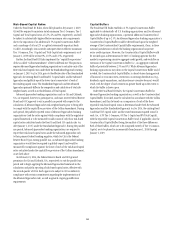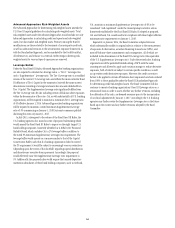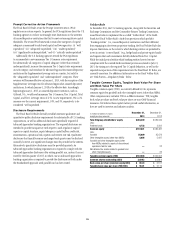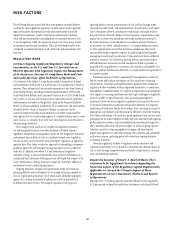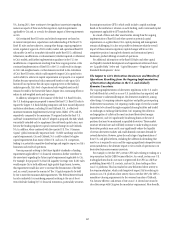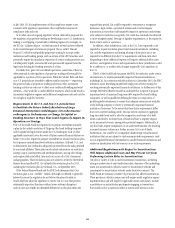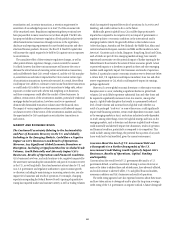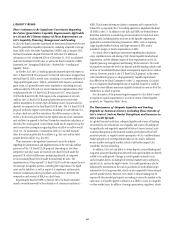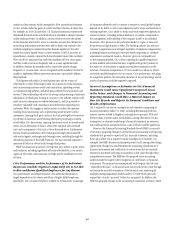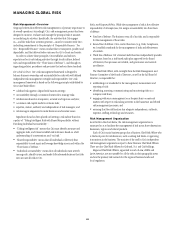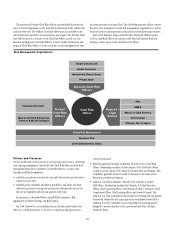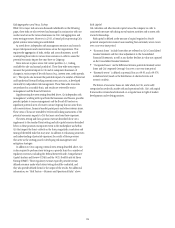Citibank 2013 Annual Report Download - page 80
Download and view the complete annual report
Please find page 80 of the 2013 Citibank annual report below. You can navigate through the pages in the report by either clicking on the pages listed below, or by using the keyword search tool below to find specific information within the annual report.62
LIQUIDITY RISKS
There Continues to Be Significant Uncertainty Regarding
the Future Quantitative Liquidity Requirements Applicable
to Citi and the Ultimate Impact of These Requirements on
Citi’s Liquidity Planning, Management and Funding.
In 2010, the Basel Committee introduced an international framework for new
Basel III quantitative liquidity requirements, including a Liquidity Coverage
Ratio (LCR) and a Net Stable Funding Ratio (NSFR) and, in January 2013,
the Basel Committee adopted final Basel III LCR rules (for additional
information on Citi’s estimated LCR as of December 31, 2013, as calculated
under the final Basel III LCR rules, as well as the Basel Committee’s NSFR
framework, see “Managing Global Risk—Market Risk—Funding and
Liquidity” below).
In October 2013, the U.S. banking agencies proposed rules with respect to
the U.S. Basel III LCR. The proposed U.S. Basel III LCR is more stringent than
the final Basel III LCR in several areas, including a (i) narrower definition of
“high-quality liquid assets” (HQLA), particularly with respect to investment
grade credit, (ii) potentially more severe standard for calculating net cash
outflows under the LCR and (iii) shorter timeline for implementation (full
compliance with the U.S. Basel III LCR by January 2017, versus January
2019 for the Basel III LCR). With respect to the computation of net cash
outflows, the U.S. Basel III LCR proposal prescribes more conservative
outflow assumptions for certain types of funding sources (in particular, for
deposits) as compared to the final Basel III LCR rules. The U.S. Basel III LCR
proposal would also require covered firms, including Citi and Citibank, N.A.,
to adopt a daily net cash flow calculation (the dollar amount on the day
within a 30-day stress period that has the highest amount of net cumulative
cash outflows) as opposed to the Basel Committee cumulative calculation at
the end of the 30-day period. Covered firms would also be required to use the
most conservative assumptions regarding when an inflow or outflow would
occur (i.e., for instruments or transactions with no or variable maturity
dates, the earliest possible date for outflows (e.g., day one) and the latest
possible date for inflows (e.g., day 30)).
There continues to be significant uncertainty across the industry
regarding the interpretation and implementation of the net cash outflows
provisions of the U.S. Basel III LCR proposal. Depending on how these
interpretive and other issues are resolved, Citi’s Basel III LCR under the
proposed U.S. rules could decrease, perhaps significantly, as compared
to Citi’s estimated Basel III LCR under the final Basel III rules. The
implementation of the proposed U.S. Basel III LCR could also impact the way
Citi manages its liquidity position, including the composition of its liquid
assets and its liabilities, as well as require it to implement and maintain
extensive compliance policies, procedures and systems to determine the
composition and amount of HQLA on a daily basis.
Regarding the Basel III NSFR, in January 2014, the Basel Committee
issued a revised framework for the calculation of a financial institution’s
NSFR. This framework remains subject to comment and is expected to be
followed by a proposal by the U.S. banking agencies to implement the Basel
III NSFR in the U.S. In addition to the LCR and NSFR, the Federal Reserve
Board has indicated it is considering various initiatives to limit short-term
funding risks, including further increases in the liquidity requirements
applicable to securities financing transactions (SFTs), such as requiring
larger liquidity buffers for firms with large amounts of SFTs, and/or
mandatory margin or haircut requirements on SFTs.
As a result, there is significant uncertainty regarding the calculation,
scope, implementation and timing of Citi’s future liquidity standards and
requirements, and the ultimate impact of these requirements on Citi, its
liquidity planning, management and funding. While uncertain, Citi could
be required to increase the level of its deposits and debt funding, which could
increase its Consolidated Balance Sheet and negatively impact its net interest
revenue. Moreover, similar to the U.S. Basel III LCR proposal, to the extent
other jurisdictions propose or adopt quantitative liquidity requirements
that differ from the Basel Committee’s or the U.S. requirements, Citi could
be at a competitive disadvantage because of its global footprint or could be
required to meet different minimum liquidity standards in some or all of the
jurisdictions in which it operates.
For a discussion of the potential negative impacts to Citi’s ability to meet
its regulatory capital requirements as a result of certain of these liquidity
proposals, see “Regulatory Risks” above.
The Maintenance of Adequate Liquidity and Funding
Depends on Numerous Factors, Including Those Outside of
Citi’s Control, Such as Market Disruptions and Increases in
Citi’s Credit Spreads.
As a global financial institution, adequate liquidity and sources of funding
are essential to Citi’s businesses. Citi’s liquidity and sources of funding can
be significantly and negatively impacted by factors it cannot control, such
as general disruptions in the financial markets, governmental fiscal and
monetary policies, or negative investor perceptions of Citi’s creditworthiness.
Market perception of sovereign default risks can also lead to inefficient
money markets and capital markets, which could further impact Citi’s
availability and cost of funding.
In addition, Citi’s cost and ability to obtain deposits, secured funding and
long-term unsecured funding from the credit and capital markets are directly
related to its credit spreads. Changes in credit spreads constantly occur
and are market-driven, including both external market factors and factors
specific to Citi, and can be highly volatile. Citi’s credit spreads may also be
influenced by movements in the costs to purchasers of credit default swaps
referenced to Citi’s long-term debt, which are also impacted by these external
and Citi-specific factors. Moreover, Citi’s ability to obtain funding may be
impaired if other market participants are seeking to access the markets at the
same time, or if market appetite is reduced, as is likely to occur in a liquidity
or other market crisis. In addition, clearing organizations, regulators, clients


